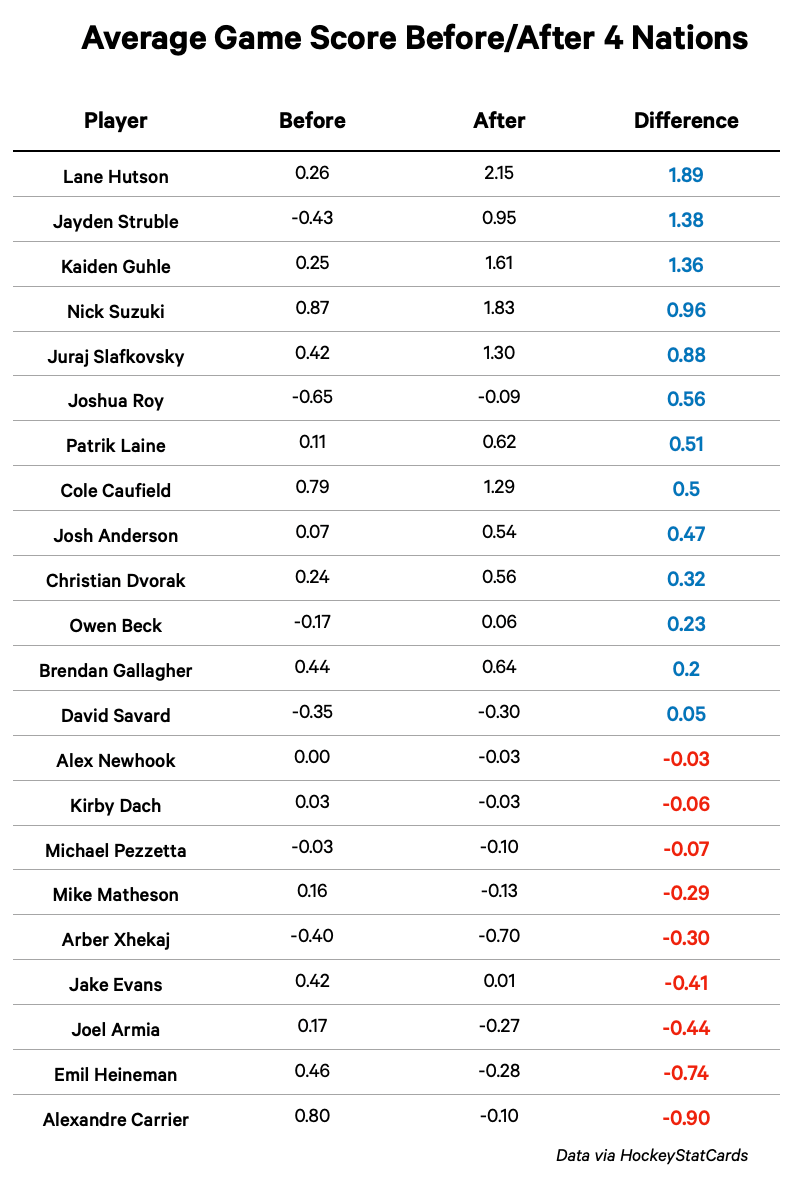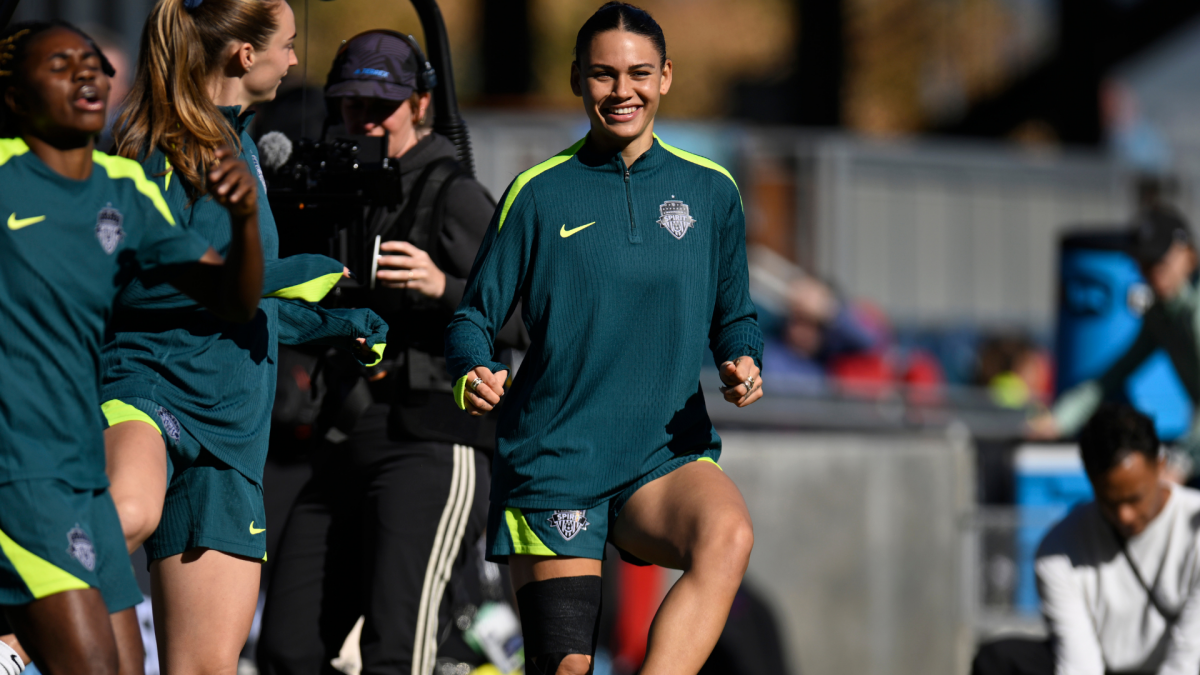
The Montreal Canadiens were only six points outside the playoff picture at the 4 Nations Face-Off break, but the team seemed a mile away from the postseason. After stumbling into the break with a 2-7-1 record, their postseason odds dropped below two percent.
Montreal needed a reset, and the break provided exactly that. The Canadiens returned to play with a purpose and started rattling off wins. It began with a 5-2 win over the Ottawa Senators and continued with a statement 4-0 victory against the Carolina Hurricanes. The points started to pile up; Montreal gained momentum with eight wins over the next 11 games and only one point-less outing.
Advertisement
When it seemed like the Canadiens were the team to beat in the wild-card race, the magic started running out. Third-period comebacks fell short in overtime. Regulation losses deflated them even further.
The Canadiens were fizzling out, and their playoff odds had slipped from a season-high of 47 percent to 29 percent. The roller-coaster season continued through this week with a home-and-home series against the Florida Panthers on tap.
They earned four points against the Panthers and reignited the spark in their playoff hopes.
Montreal’s playoff chances are up to a season-high 48 percent as of Wednesday morning. After a tough stretch, the Canadiens have the juice to turn those chances into a reality.
Young stars shining bright
Three players are at the heart of the Canadiens’ turnaround: Nick Suzuki, Lane Hutson and Sam Montembeault.
Suzuki has been a pivotal player this season and the home-and-home against Florida gave a glimpse into that. With more control over the matchups on Sunday, the Panthers matched their best defender, Gustav Forsling, up against Suzuki. In 11:40 of head-to-head minutes at five-on-five, the teams broke even in scoring 1-1. But Suzuki and the Canadiens controlled play with 76 percent of the expected goal share.
At home on Tuesday, Suzuki and the Canadiens’ top line were shut down for much of the game, with no one scoring at five-on-five. But even though he wasn’t up to his usual two-way heights, he still came up big when it mattered most with a six-on-five goal to tie the game and then one to win it in overtime. Good players win their minutes nightly, while great players can be the difference without being on their A-game.
Suzuki has emerged as a difference-maker for the Canadiens. His two-way play and puck-moving ability are strengths for this team, as is his clutch scoring. And that has a trickle-down effect on the players around him — especially his wingers on that top line, Cole Caufield and Juraj Slafkovský.
Caufield has generally been the primary shooter on that line and has the finishing talent to match. But since the break, Slafkovský has added a bit more dimension to that line, emphasizing his shot volume and quality to complement his high-danger passing ability.
Advertisement
Through the first 56 games, the Canadiens’ top line outscored opponents 26-20. Since the 4 Nations break, the trio has completely elevated their games on both ends of the ice. The line’s 16-7 scoring edge over the last 18 games isn’t the result of a spike in their on-ice shooting percentage; the three are just controlling play more in their minutes with an uptick in offense and less going back the other way for a 54 percent expected goal rate. That success has translated to the power play, too.
That leading line tends to share the ice, both at even strength and on the power play, with Hutson, who has become the team’s engine from the blue line.
The Canadiens have created a lot of high-end offense in Hutson’s minutes all season long. Anticipation and smooth skating are cornerstones of his game. Hutson is a breakout machine who draws opponents to him, creating time and space for his teammates to get in scoring position. He has a lot of poise with the puck, which helps him operate under pressure, especially down the stretch.
Hutson’s game has progressed throughout the season. Through the first 56 games of the year, the team fell below break-even because of how leaky its defense was. Montreal gave up 3.12 expected goals against per 60 in Hutson’s minutes at five-on-five. That has decreased by almost an entire goal since 4 Nations, with his offense ticking up over the last 18 games, too, for a 61 percent expected goal share (a 13 percent improvement). Huston can’t beat opponents with his size and strength, but his anticipation is the difference — it just took time for that to develop against NHL-caliber opponents.
Usage benefits Hutson because he doesn’t have to shoulder matchup minutes; Mike Matheson and Alexandre Carrier do. And he benefits from sharing the ice with the team’s best forwards — if he primarily skated with the bottom six, the forwards likely wouldn’t be able to convert on his setups at this high rate. But playing with the team’s best can also mean high-leverage minutes in pivotal games. Sunday’s game against Florida was an example of that. Hutson may not have had heavy primary matchups against Aleksander Barkov and Sam Reinhart, but he still played high-pressure minutes against one of the best teams in the East. And in almost 20 minutes of five-on-five action, he helped the Canadiens dominate play with 69 percent of the expected goal share and a 1-0 scoring advantage.
Advertisement
With more support on both ends of the ice, led by Suzuki and Hutson, Montembeault is also in a better position in goal.
The Canadiens were one of the worst five-on-five teams at the 4 Nations break, with a 47 percent expected goal rate that ranked 27th in the league. Montreal was one of the worst defensive teams in the league, and its goalies couldn’t contain the damage in front of them. While this team is still flawed defensively, there have been incremental improvements, which extend to the blue paint. Montembeault and Jakub Dobes have a combined 0.913 save percentage at five-on-five over the last 18 games. When accounting for shot quality, Montembeault’s numbers are especially eye-catching. He had some tough outings against the Blues and Hurricanes, but has given his team a chance to win with a quality start in 10 of his last 14 starts while saving 10.9 goals above expected along the way.
Improved depth and secondary scoring
Relying on three players isn’t exactly a perfect recipe for success. But Suzuki, Hutson and Montembeault aren’t doing this alone; they are just the primary drivers of the team’s success. Slafkovský and Caufield are high-end parts of the top line. Jayden Struble and Kaiden Guhle have made real improvements on the back end, as have veterans Brendan Gallagher, Josh Anderson and Christian Dvorak, who have provided some secondary scoring over this last stretch.
Red flags, but meaningful hockey
There are still red flags in Montreal, which likely won’t change enough over the next eight games. There is an overreliance on the top line, as the team has been outscored 26-18 with them on the bench at five-on-five over the last 18 games. Defense is still a problem, and that extends past even strength and onto the penalty kill. Goaltending may have masked those short-handed woes for a while, but the Canadiens have given up seven power-play goals in their last seven games.
The Canadiens have had several third-period comebacks over this last stretch. But that isn’t the most sustainable way to succeed, either. Those comeback efforts earned Montreal a point against the Islanders and Avalanche, but it wasn’t enough to beat the Flyers last week.
If the Eastern Conference around them wasn’t so flawed, the Canadiens might not be in the picture despite their post-4 Nations surge. The Blue Jackets opened March with eight losses in 10 games. The Rangers have been an inconsistent mess. The Islanders have wilted. The Red Wings can’t overcome their demanding schedule. But those teams’ shortcomings opened the door to another team disrupting the playoff picture, and the Canadiens ran with the opportunity. When the wheels started to come off, Montreal responded with back-to-back wins fueled by its stars.
A lot can still change in the next eight games — the Canadiens’ playoff odds may have jumped up, but this team is far from a lock. The team could fall short and miss the postseason. Or Montreal could make it and get swept by the first-place Capitals.
Advertisement
The short-term outcomes may be front of mind right now. But the big picture matters most for this team. The Canadiens were never expected to be in the playoff mix, let alone leading the field for the last spot. But this team is here, and not because veteran players are driving the bus. The skill and resilience of Montreal’s up-and-coming core have fueled this run. Unlike the last couple of seasons, this team is playing meaningful hockey down the stretch and striving for something more than just a top draft pick.
The Canadiens are gaining seasoning that will help build toward the next window of contention — and it is thanks to the progress and development of players who are the next cornerstones of that window.
— Data via Evolving-Hockey, HockeyViz, HockeyStatCards, All Three Zones and Natural Stat Trick. This story relies on shot-based metrics; here is a primer on these numbers
(Top photo: Minas Panagiotakis / Getty Images)
This news was originally published on this post .








Be the first to leave a comment